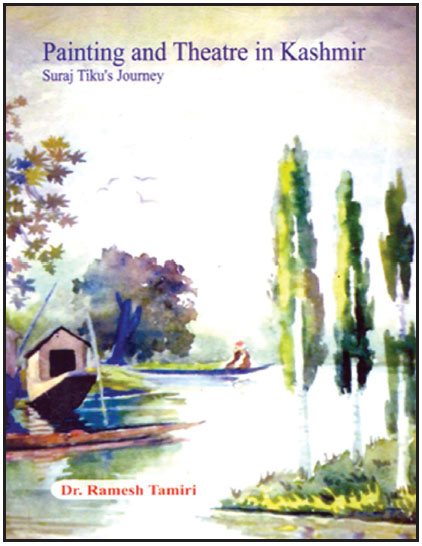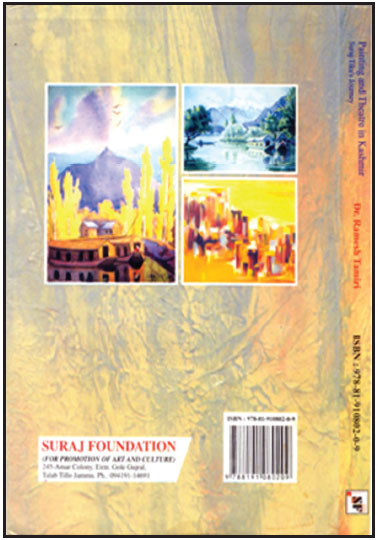November 2011
Title:
Painting and Theatre in Kashmir—Suraj Tiku’s Journey
Author:
Dr. Ramesh Tamiri
Published
By: Suraj Foundation,Jammu
Price:
Rs. 650 (HB), Rs300 (PB)
By Upender Ambardar
‘Painting and Theatre in Kashmir—Suraj Tiku’s Journey’, authored
by Dr. Ramesh Tamiri, is a pioneering work. Its central focus is the life and
work of Suraj Tiku, a talented painter, set designer and a versatile theatre
actor. The book has three thematic sections. The first section includes three
chapters—1.Painting in Kashmir—A historical overview 2.Theatre in
Kashmir-A brief History and 3.Kashi Nath Bhan—Suraj Tiku’s Guru. The first
two chapters, which trace the development of painting and theatre in Kashmir,
give the book an encyclopedic dimension. The sheer amount of information given
in these chapters makes it a valuable reference book on painting and theatre
in Kashmir.
Dr. Tamiri gives useful insights in to the role of Sir Amar Singh Technical
School in training the first group of Kashmiris in landscape and portrait
painting. For the first time the contribution of British painters in painting
Kashmir has been documented. The author asserts that Kashmir had its own
school of Painting in ancient times. He refers to the valuable contribution to
art during Buddhist era. The telling testimonials of it are the unrivalled
wall paintings of Alchi,Spiti and Western Tibet monastries. These evoke
admiration and awe even today. Their historical linkage is traced to artistic
fruition and excellence of Kashmiri artists as painting had acquired a
divinized status during the time. The author refers to Mirza Haider Dughlat,
who acknowledged artistic grandeur of wall Paintings in temples of Kashmir.Dr.
Tamiri sees continuity in painting tradition in Kashmir. He remarks that
Kashmiri artists formed a sizable group in Mughal courts. Muhammad Husayn
Zarrin Qalam was the most prominent among these.Dr. Tamiri quotes the research
work of renowned art historian, Barbara Schmitz who suggests that Kashmir was
an entrepot for artists from India,Persia and Central Asia. It was from
Kashmir that Mughal painting based on European examples of volumetric figures
and recessional space, was first introduced to the Persian court at Isfahan
and the Central Asian court at Bukhara. Due to hostile conditions at
home many artists left Kashmir in late sixteenth century and sought refuge in
the adjoining princely hill states. It were these artists who became the
pioneers of Pahari School of painting. Pandit Seu Raina was the founding
father of Pahari School of painting. The author also records the role of other
schools of Kashmiri miniature painting. The master painters of these schools
were Tota Ram Naqash ,three generations of Tota Clan, Narayan Murutgar and
many others. Contibutions of talented artists—ShivNath Raina, Som Nath Khosa
and Jagar Nath Sapru, the products of Sir Amar Singh Technical School,based on
the details provided by their families, are well highlighted.


The chapter on Theatre history provides insights in to the evolution of
theatre in Kashmir. The role of Raas leela and Ram Leela groups and the
contribution of Parsi Theatre have been discussed well in how it provided the
initial impulses to Kashmiris for theatre. Dr. Tamiri provides detailed
information about early theatre groups like Amateur Dramatic Club, Kashmir
Dramatic Club, Saraswati Dramatic Club, Kashmir Theatrical Company, Natak
Vibag, etc. The impressive range of artistes covered by the author include
Jagar nath Saqi , Madhav Dass, Ved Lal Dhar Vakil, Shamboonath Bhan, Shamboo
nath Kaul, Mohammad Shaban, Abdul Satar Asi, Shafi Mir and many others.Kala
Kendra and Cultural Front were two important theatre groups which were behind
the cultural upsurge in the post-independence era in Kashmir. There is rich
material on this in the book. The author has discussed the role of Moti Lal
Kemmu in upgrading and recasting Bhand Paather, popular folk theatre.The
strides in playwrighting find a prominent place in the narrative.
The immense contribution of legendary set designer, master painter and
pioneer of Parsi theatre in Kashmir, Kashi Nath Bhan has been for the first
time documented. Bhan was Suraj Tiku’s mentor in the genres the latter
practiced. The narrative is rich with interesting anecdotes about the life and
work of Kashi Nath Bhan.
The second section of the book is entirely devoted to the personal and
professional odyssey of Suraj Tiku. The latter distinguished as master
landscape and portrait painter, a great set designer and a talented theatre
actor.Tiku was also good in modern art.Suraj Tiku’s sense of great humour
and personal traits also find mention.Tiku’s extreme humility is probably
the main reason for his belated recognition. The concluding section details
the contribution of members of Tiku clan to theatre.Many families in Kashmir
have their even second and third generations also involved in fine and
performing arts. These include those of Ved Lal Dhar Vakil,Som Nath Khosa,Prem
Nath Pardesi, Madhav Dass, Shiv Nath Raina, Madhav Tiku, Moti Lal Kemu,Ghulam
Rassol Santosh, Sajood Sailani, etc.
Dr. Tamiri has shown how use of oral history can be harnessed well for
research. The rare photographs of artists, theatre actors,theatre
scenes and paintings of Suraj Tiku that embellish the book are a reader’s
delight. The rich content of the book and its readability will appeal to the
scholar and laymen alike.
